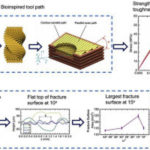Strength and toughness enhancement in 3d printing via bioinspired tool path
Mechanical properties such as strength, toughness and anisotropy are significant in 3D printing technology. Unfortunately, the strength and toughness are often mutually exclusive, and are therefore difficult to be enhanced simultaneously. Here, a bioinspired parallel-scan path is proposed to increase both the strength and toughness with in-plane isotropy. In this method, a Bouligand structure is adopted to increase the fracture deflection and energy absorption. Result shows that at the optimal rotational angle 15°, the ultimate strength and toughness can be improved over 12% and 100%, respectively, along with good in-plane isotropy. To investigate the mechanics of the improvement, the fracture surface is analyzed and the finite element (FE) simulation is performed. Our results suggest that the optimal mechanical properties can be obtained at a certain rotational angle by controlling the stress under a moderate level, and maximizing the fracture surface during its propagation. The method is simple and highly adaptive, and may offer a good mechanical reinforce capability in extrusion based 3d printing.
Learn about our two Decals!
 Click here to find out more about our Fall Bioinspired Design Decal and our Spring Bioinspired Design in Action Decal – ALL MAJORS are welcome.
Click here to find out more about our Fall Bioinspired Design Decal and our Spring Bioinspired Design in Action Decal – ALL MAJORS are welcome.Berkeley BioDesign Community
 Click here to learn about the BioD: Bio-Inspired Design @ Berkeley student organization or here to signup for more info.
Click here to learn about the BioD: Bio-Inspired Design @ Berkeley student organization or here to signup for more info.Search
Student Login




I imagine that the neurological circuits underlying these processes are governed by both 2d spacing maps with their brains as…
to reduce the impact of car accidents, it may be possible to study the force diverting physics of cockroaches to…
you see this type of head-bobbing stability in many avian creatures related to pigeons like chickens. the head ability to…
not like they taught horses how to run! this is an example of convergent evolution where both sea creatures and…
The brain functions in a similar way with neuronal connections. our brains are able to utilize the multiplicity of connections…